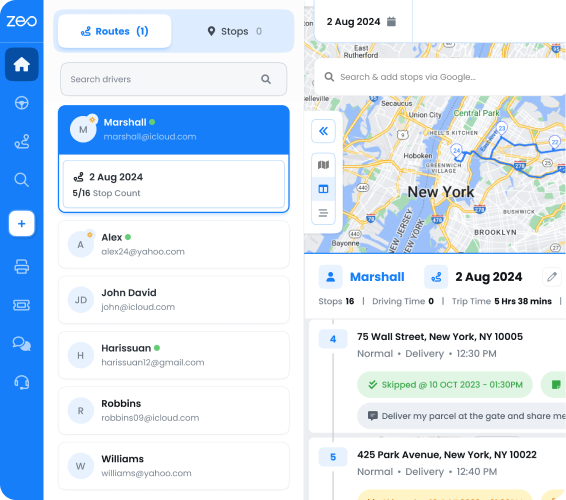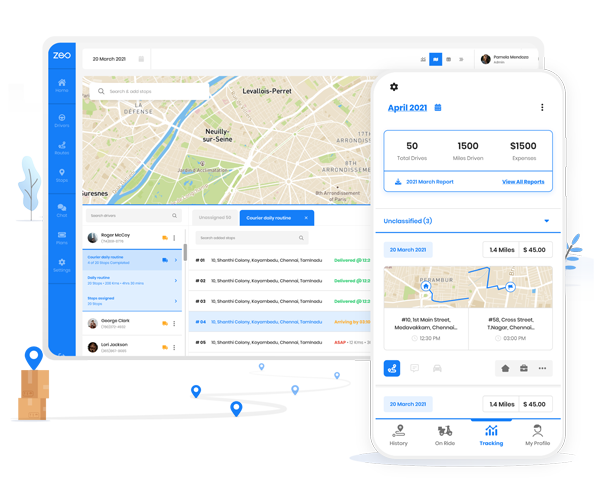Freight shipping is essential in global trade because it allows for easy movement of commodities from one area to another. Whether a tiny box or a huge shipment, efficient and dependable freight transportation is critical for businesses to meet ever-increasing client needs.
In this detailed guide, we will delve into the world of freight shipping, addressing its definition, procedures, top carriers used by eCommerce organizations, preparations, and the role of Zeo Route Planner in assisting freight shipments.
What is Freight Shipping?
Freight shipping transfers commodities or cargo using various modalities such as trucks, trains, ships, or airplanes. Unlike parcel shipping, which often involves smaller products, freight shipping concentrates on larger shipments that require specialized handling and transportation.
What are the 5 Methods of Freight Shipping?
There are various methods of freight shipments suitable for specific requirements::
- FTL (Full Truckload) shipping entails using a whole vehicle for a single consignment. Because the entire trailer is committed to one customer’s cargo, this strategy is cost-effective for large shipments.
- LTL (Less Than Truckload) shipping combines smaller shipments from various customers into a single truckload. This strategy is great for organizations with smaller shipments that do not require an entire vehicle.
- PTL (Partial Truckload) shipping includes both FTL and LTL shipping aspects. It entails sharing a truckload with other customers without extra stops for pick-ups or drop-offs, resulting in shorter travel times and less handling.
- Intermodal shipping transports commodities through various mediums, such as trucks, trains, and ships. This strategy provides flexibility, economic savings, and environmental benefits, especially when shipping long distances or internationally.
- Expedited shipping prioritizes time-sensitive or urgent shipments, aiming for speedier delivery via dedicated transportation and optimized logistics operations.
Read more: The Role of Route Optimization in E-Commerce Delivery.
What are the Top 3 Freight Carriers used by E-Commerce Companies?
When it comes to freight transportation, eCommerce companies frequently rely on established carriers known for their dependability, coverage, and specialized services. The top three carriers in this domain are:
UPS Freight: UPS Freight offers a wide range of freight transportation services, including LTL, FTL, and specialized solutions. Their broad network, excellent technology, and dedication to customer satisfaction make them a popular choice for eCommerce firms.
FedEx Freight: FedEx Freight provides a variety of freight delivery alternatives, including LTL, FTL, and expedited services. They are a favorite carrier for many eCommerce enterprises due to their extensive network, excellent tracking features, and reputation for quick delivery.
XPO Logistics: XPO Logistics is a multinational transportation and logistics firm that provides a full range of freight shipping services. Their expertise in handling complicated supply chains, modern technology solutions, and large networks make them a top choice for eCommerce enterprises looking for efficient and dependable freight transportation.
How to Prepare a Freight Shipment?
Here are some essential procedures that you need to follow to ensure a seamless and successful freight shipment:
Establish Shipment Specifics: Determine your goods’ weight, size, and nature. This information will assist you in selecting the best freight shipment method and carrier.
Packaging and Labeling: Protect your items throughout transit by properly packaging them. Use strong materials, padding, and safe packaging practices. In addition, clearly label your packages with addresses, tracking numbers, and special handling instructions.
Documentation: Prepare the required shipment documentation, such as the bill, commercial invoice, and other customs or regulatory documents. For customs clearance and easy transit, accurate and full documentation is required.
Freight Classification and NMFC Codes: Choose the appropriate freight class for your consignment. The National Motor Freight Traffic Association (NMFTA) classifies items based on density, value, and handling characteristics. For accurate pricing and billing, obtain the right NMFC code.

increase fuel savings
Save $200 on fuel, Monthly!
Optimize routes with our algorithm, reducing travel time and costs efficiently.
Get Started for Free
Carrier Selection: Research a reliable freight carrier that meets your transportation requirements. Consider coverage, service quality, transit times, cost, and other services.
Request Quotes and Book Shipment: Contact several carriers to acquire freight quotes based on the specifics of your shipment. Before making a final decision, compare costs, services, and transportation times. Once you’ve decided on a carrier, reserve space for your package ahead of time to ensure prompt collection.
Track and Monitor Package: Use the carrier’s tracking features to track the progress of your package. Maintain contact with the carrier to resolve any potential concerns or changes in delivery arrangements.
Zeo’s Role in Freight Shipping Deliveries
Zeo Route Planner is a cutting-edge delivery management application that significantly expedites and optimizes freight transportation operations:
Route Planning: It uses powerful algorithms to calculate the most effective routes for several shipments, decreasing travel time, fuel expenditures, and carbon emissions.
Load Optimization: The tool optimizes load distribution within trucks by considering weight constraints, cubic capacity, and special handling needs. This maximizes area use while reducing the number of vehicles necessary.
Real-Time Tracking: Zeo Route Planner provides shipments with real-time tracking and visibility, allowing you to track the progress of your freight and deliver accurate updates to your clients.
Analytics and Reporting: It offers detailed analytics and reporting features, providing valuable insights into shipment performance, transit times, and more. This data helps identify areas for improvement and supports informed decision-making.
Wrapping Up
Freight shipping is critical to the success of eCommerce businesses because it allows for the efficient and dependable conveyance of goods. It helps businesses expedite their shipping procedures, improve customer happiness, and optimize their supply chain operations by knowing the various modes of freight shipment, using reputable carriers, and leveraging technology solutions like the Zeo Route Planner.
Book a free demo today to learn more about our tool and experience the benefits!
Read more: How to Increase Payload Capacity of Delivery Vehicles?

Are you a fleet owner?
Want to manage your drivers and deliveries easily?
Grow your business effortlessly with Zeo Routes Planner – optimize routes and manage multiple drivers with ease.

increase fuel savings
Hassle Free Deliveries & Pickups!
Optimize routes with our algorithm, reducing travel time and costs efficiently.
Get Started for Free




















